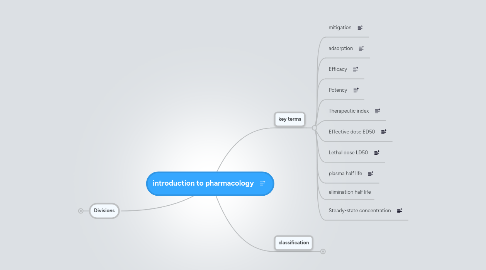
1. key terms
1.1. mitigation
1.2. adsorption
1.3. Efficacy
1.4. Potency
1.5. Therapeutic index
1.6. Effective dose ED50
1.7. Lethal dose LD50
1.8. plasma half life
1.9. elimination half life
1.10. Steady-state concentration
2. classification
2.1. organ system
2.1.1. neuropharmacology
2.1.2. cardiovascular pharmacology
2.1.3. renal
2.1.4. pulmonary
2.2. techniques used
2.2.1. molecular
2.2.2. biochemical
2.2.3. immuno
2.2.4. behavioral
2.3. purpose of application
2.3.1. clinical
2.3.2. toxicolog
2.3.3. genetics
2.3.4. agricultural
3. Divisions
3.1. Toxicology
3.1.1. concepts
3.1.1.1. toxic substance
3.1.1.2. toxin
3.1.1.3. Paracelsus concept
3.1.1.3.1. drugs may have toxic side effects
3.1.1.4. management concept
3.1.1.5. groups at highest risk
3.1.1.5.1. children1-3 years
3.1.1.5.2. adolescence
3.1.1.5.3. common between the two groups
3.1.2. reversibility
3.1.2.1. depends on capacity of the tissue to regenerate
3.1.2.2. examples
3.1.2.2.1. liver
3.1.2.2.2. CNS
3.1.3. classification
3.1.3.1. target organ
3.1.3.1.1. cardio toxic
3.1.3.1.2. hepatotoxic
3.1.3.1.3. neurotoxic
3.1.3.1.4. nephrotoxic
3.1.3.2. use
3.1.3.2.1. pesticides
3.1.3.2.2. food additives
3.1.3.2.3. solvents
3.1.3.3. source
3.1.3.3.1. animal
3.1.3.3.2. plant
3.1.3.4. type of effect
3.1.3.4.1. carcinogenicity
3.1.3.4.2. mutagenicity
3.1.3.4.3. teratogenicity
3.1.3.5. lethality
3.1.3.5.1. extremely toxic
3.1.3.5.2. highly toxic
3.1.3.5.3. moderately toxic
3.1.3.5.4. slightly toxic
3.1.3.5.5. practically non toxic
3.1.3.5.6. relatively hermless
3.1.3.6. other
3.1.3.6.1. physical state
3.1.3.6.2. reactivity
3.1.3.6.3. chemical structure
3.1.4. duration of toxicity
3.1.4.1. acute
3.1.4.2. sub-acute
3.1.4.3. chronic
3.2. Pharmacoeconomics
3.3. Pharmacoepidemiology
3.4. Pharmacogenetics
3.5. Pharmacotherapy
3.5.1. using drugs to active a therapeutic objective
3.5.1.1. Cure of infection
3.5.1.2. Mitigation of pain or fever
3.5.1.3. Prevention
3.5.1.4. Supplementation
3.5.1.5. General anesthesia
3.5.2. Rule of right
3.5.2.1. right drug
3.5.2.2. right patient
3.5.2.3. right does
3.5.2.4. right cost
3.5.3. SANE criteria
3.5.3.1. Safety
3.5.3.2. Affordability
3.5.3.3. Need
3.5.3.4. Efficacy
3.5.3.5. Preferred drug
3.6. Pharmacogenomics
3.7. Pharmacodynamics
3.7.1. Action
3.7.1.1. types of actions
3.7.1.1.1. stimulation
3.7.1.1.2. depression
3.7.1.1.3. both
3.7.1.1.4. inhibition
3.7.1.1.5. replacement
3.7.1.1.6. Cytotoxic
3.7.1.1.7. Neutralization
3.7.1.2. receptors
3.7.1.2.1. generalized receptors
3.7.1.2.2. specialized receptors
3.7.1.3. Targets
3.7.1.3.1. Molecular level
3.7.1.3.2. Cellular level
3.7.1.3.3. Tissuey level
3.7.1.3.4. systemic level
3.7.1.4. Affinity
3.7.1.5. Efficacy
3.7.1.6. classification of drugs
3.7.1.6.1. agonist
3.7.1.6.2. partial agonist
3.7.1.6.3. inverse agonist
3.7.1.6.4. antagonis
3.7.2. Effect
3.8. pharmacokinetics
3.8.1. absorbtion
3.8.1.1. Routs of administration
3.8.1.1.1. Enteral
3.8.1.1.2. Parenteral
3.8.1.2. involves passage through
3.8.1.2.1. passive diffusion
3.8.1.2.2. filtration
3.8.1.2.3. active transport
3.8.1.2.4. facilitated diffusion
3.8.1.2.5. endocytosis
3.8.1.3. factors affecting absorption
3.8.1.3.1. physiological factors
3.8.1.3.2. physiochemical factors
3.8.1.4. Bioavailability
3.8.1.4.1. None-intravenous administration
3.8.1.4.2. intravenous
3.8.1.4.3. Bioequivalence
3.8.2. distribution
3.8.2.1. rate-determening factors
3.8.2.1.1. cardiac output
3.8.2.1.2. regional blood flow
3.8.2.1.3. lipid solubility
3.8.2.1.4. binding to plasma protein
3.8.2.2. organs that receives most of the drug initially
3.8.2.2.1. brain
3.8.2.2.2. liver
3.8.2.2.3. kidney
3.8.2.3. binding to drug carriers
3.8.2.3.1. Albumin
3.8.2.3.2. alpha-1-acid glycoprotein
3.8.2.3.3. binding affinity
3.8.3. elimination
3.8.3.1. metabolism
3.8.3.1.1. if the drug is metabolized, it may be
3.8.3.2. excretion
3.8.3.2.1. kidneys
3.8.3.2.2. intestinal tract
3.8.3.2.3. breast milk
3.8.3.2.4. sweat
3.8.3.2.5. lungs
